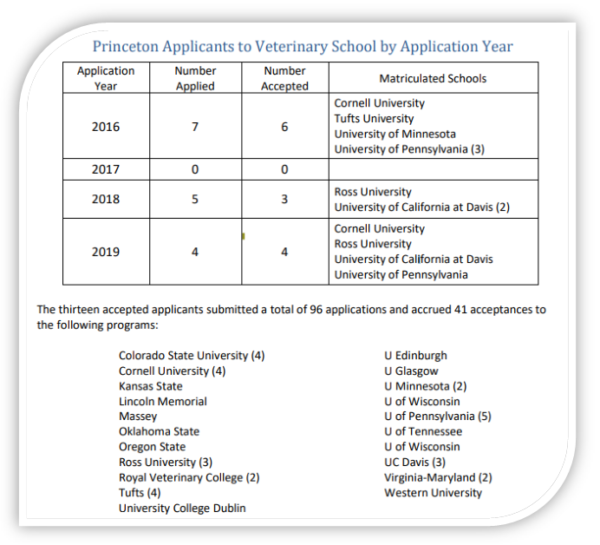Vet school students deal with dozens of species while medical school students focus primarily on humans. The MCAT is usually not required unlike medical school and instead most require the GRE. While both require letters of recommendation, HPA committee letters are not required for vet school. Students take challenging courses in the biological sciences early on and participate in rotations later on in both vet and med school. One additional interesting difference is that vet schools have a set number of in-state seats and out-of-state seats, which means applicants are usually only competing with residents if they are residents or non-residents if they are non-residents for admission. Tuition is also substantially lower for resident students.
How many vet schools are there and where are they located?
As of Summer 2020, there are 32 American, 5 Canadian, and 16 international veterinary medicine colleges accredited by the AVMA (American Veterinary Medical Association). Accreditation may change for various reasons and lists are biannually updated here.
ACCREDITED COLLEGES IN THE UNITED STATES:
- Auburn University (Alabama)
- Tuskegee University (Alabama)
- Midwestern University (Arizona)
- University of Arizona (Arizona)
- University of California – Davis (California)
- Western University of Health Sciences (California)
- Colorado State University (Colorado)
- University of Florida (Florida)
- University of Georgia (Georgia)
- University of Illinois (Illinois)
- Purdue University (Indiana)
- Iowa State University (Iowa)
- Kansas State University (Kansas)
- Louisiana State University (Louisiana)
- Tufts University (Massachusetts)
- Michigan State University (Michigan)
- University of Minnesota (Minnesota)
- Mississippi State University (Mississippi)
- University of Missouri-Columbia (Missouri)
- Cornell University (New York)
- Long Island University (New York)
- North Carolina State University (North Carolina)
- The Ohio State University (Ohio)
- Oklahoma State University (Oklahoma)
- Oregon State University (Oregon)
- University of Pennsylvania (Pennsylvania)
- University of Tennessee (Tennessee)
- Lincoln Memorial University (Tennessee)
- Texas A&M University (Texas)
- Virginia-Maryland Regional College (Virginia + Maryland)
- Washington State University (Washington)
- University of Wisconsin-Madison (Wisconsin)
The following 22 US states currently do not have vet schools:
- Alaska
- Arkansas
- Connecticut
- Delaware
- Hawaii
- Idaho
- Kentucky
- Maine
- Montana
- Nebraska
- Nevada
- New Hampshire
- New Jersey
- New Mexico
- North Dakota
- Rhode Island
- South Carolina
- South Dakota
- Utah
- Vermont
- West Virginia
- Wyoming
ACCREDITED COLLEGES IN CANADA:
- University of Calgary (Alberta)
- University of Guelph (Ontario)
- University of Prince Edward Island (Prince Edward Island)
- Université de Montréal (Quebec)
- University of Saskatchewan (Saskatchewan)
ACCREDITED COLLEGE INTERNATIONALLY:
- Murdoch University (Australia)
- The University of Sydney (Australia)
- University of Melbourne (Australia)
- University of Queensland (Australia)
- University of Bristol (England)
- University of London – Royal Veterinary College (England)
- VetAgro Sup (France)
- University College, Dublin (Ireland)
- Universidad Nacional Autonoma de México (Mexico)
- State University of Utrecht (The Netherlands)
- Massey University College of Sciences (New Zealand)
- University of Glasgow (Scotland)
- The University of Edinburgh (Scotland)
- Seoul National University (South Korea)
- Ross University (West Indies)
- St. George’s University (West Indies)
Is it easier to get into an in-state vet school than an out-of-state vet school?
It is very possible to make the case that it is usually relatively easier to get accepted to a vet school in your state than a vet school out of your state.
For example, Ohio State’s incoming Class of 2022 consisted of 66 residents and 96 non-residents and the school had received 245 resident and 1144 non-resident applicants. The acceptance rate for residents is 27% compared to 8% for non-residents. The difference is significant! However, these stats are not based off of all the students that were offered admission, including ones that declined acceptances.
University of Florida offered admission to 102 residents out of a total of 433 resident applicants and offered admission to 95 non-residents out of a total of 809 non-resident applicants for the Class of 2023. This amounts to a 24% acceptance rate for residents, double that of the non-resident acceptance rate (12%).
As a final example, UCDavis offered admission to 128 residents out of a total of 510 resident applicants and offered admission to 6only 20 non-residents out of a total 502 non-residents applicants. This amounts to a 25% acceptance rate for residents and only a 4% acceptance rate for non-residents. Admitted residents also had much lower science GPAs on average (3.62) compared to non-residents (3.96).
Our final verdict is: where you live can definitely impact your chances of getting accepted into vet school. However, you can’t just pack your bags right before submitting your application and move to the state with your dream vet school. Applicants have to submit proof of residency for at least a certain amount of time (usually 1-2 years) in order to be considered residents.
There are still 22 states without vet schools. So the question that remains is: are those students at a disadvantage? While not entirely clear, some states without vet schools like New Jersey sign contracts with states that do have vet schools to reserve a set number of seats and discounted tuition rates for students. If you are located in one of the 22 states, research whether your state has similar to New Jersey’s policies as shown below:
The Veterinary Medical Education Act of 1971 provides for contractual agreements between the New Jersey Department of Higher Education and out-of-state schools of veterinary medicine for the acceptance of New Jersey residents who are and have been residents of the state of New Jersey for 12 consecutive months. Under the terms of the act, the schools receive a substantial subsidy toward educational costs in return for a number of guaranteed reserved seats, at in-state tuition and/or reduced fees, for New Jersey residents. At present, New Jersey has contractual agreements with the following schools: New York State College of Veterinary Medicine of Cornell University, University of Pennsylvania School of Veterinary Medicine, Tufts University, Iowa State University, Kansas State University, Oklahoma State University, and Tuskegee University School of Veterinary Medicine, all of which reserve seats for New Jersey residents. As of 2003, 24 spaces were available. Students are encouraged to apply to all of these institutions in order to increase their chances of acceptance. Most schools of veterinary medicine also admit a few out-of-state residents without specific contracts.
What schools have Princeton students have recently applied to and matriculated at?
According to HPA, the following vet schools received the most applications from Princeton students from 2012-2016:
- Colorado State University College of Veterinary Medicine & Biomedical Sciences
- Cornell University College of Veterinary Medicine
- North Carolina State Veterinary Medicine
- Tufts University Cummings School of Veterinary Medicine
- University of California Davis School of Veterinary Medicine
- University of Minnesota-Twin Cities College of Veterinary Medicine
- University of Pennsylvania School of Veterinary Medicine
- University of Wisconsin School of Veterinary Medicine
Princeton students have matriculated at the following schools from 2012-2016:
- Cornell University College of Veterinary Medicine
- North Carolina State Veterinary Medicine
- Tufts University Cummings School of Veterinary Medicine
- University of Pennsylvania School of Veterinary Medicine
HPA has now released more updated, in-depth data from the past four application cycles:

